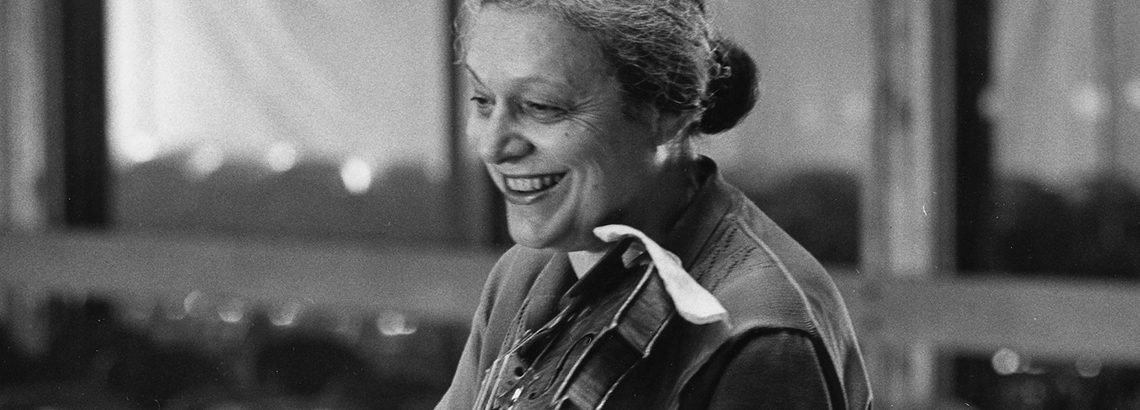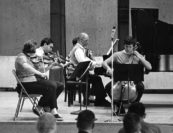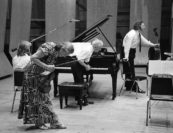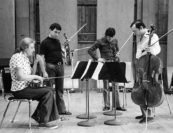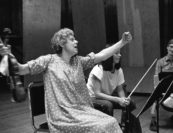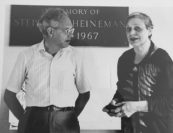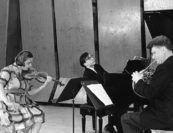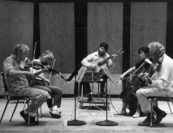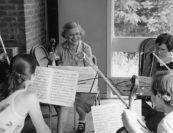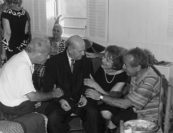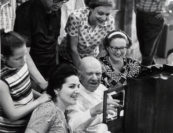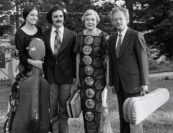As soloist with the famed Italian chamber orchestra I Musici, Pina Carmirelli probably played Vivaldi’s Four Seasons more than any other violinist, captivating audiences around the world on tour and on acclaimed recordings. A passionate advocate for the works of Boccherini, she formed the Boccherini Quintet in 1950 with her husband, the cellist Arturo Bonucci, to share the composer’s delightful but neglected works with two celli. Four years later, she formed the Carmirelli String Quartet, deepening her commitment to chamber music while also pursuing a solo career.
Pina Carmirelli first came to Marlboro in 1964, soon after the death of her husband. Although she participated fully, she was still very much in mourning when she arrived, consumed by sadness and always dressed in black. Halfway through the summer, I recall standing on the Dining Hall steps and seeing an unfamiliar person wearing a brightly-colored floral blouse. Not until she was 10 feet away did I recognize a transformed Pina Carmirelli. At the end of the summer when she met with Administrator Anthony Checchia, she confided that the music and community she found at Marlboro had assuaged her sorrow and made her feel part of a family again.
For her part, Pina Carmirelli brought a singular voice to the community with her dynamic musical presence and served as an important role model for young artists—particularly female string players. A person of few words, she, like Rudolf Serkin, spoke in rehearsals primarily through her instrument. I recall taking Katherine Graham, publisher of the Washington Post and close Serkin family friend, to a rehearsal of the Brahms Piano Quintet in which Carmirelli and Serkin both played. The only voice we heard was that of the 20-something cellist. Though reserved socially, Carmirelli was a force of nature with an instrument in her hands.
One of Marlboro’s ongoing strengths is its ability to expose exceptional young professionals to a variety of musical viewpoints, and Carmirelli was particularly generous in sharing hers. She played diverse repertoire from her very first summer at Marlboro: Bach, Beethoven, Boccherini, Mozart, and Brahms. Her big sound may not always have fit the traditional senior second violin seat, but whatever her role, she made important contributions to every group.
Rudolf Serkin, in fact, was so taken with Carmirelli’s playing that, in 1966, he joined her for three concerts at Carnegie Hall, playing the complete Beethoven Sonatas for Violin and Piano for the bicentenary of the composer’s birth. Serkin had only performed these works once before, 30 years earlier, with his father-in-law, Adolf Busch, whom he revered. In reviewing the opening concert of the series, a New York Times critic wrote, “The pianist was Rudolf Serkin who needs no introduction; the violinist was Pina Carmirelli, who does. But it should be said right away that she is every bit as distinguished an artist as her colleague, and the duo’s playing was one of the early delights of a season that promises a great many.”
Have a listen to the SONY Marlboro recording of the Brahms Sextet in G Major, Op. 36, and the Boccherini Quintet in C Major, Op. 25, No. 4, and you will have a good idea of the depth of Pina Carmirelli’s contribution to Marlboro.
Marlboro Trustee Luisa Saffiotti shared this illuminating interview that Allen Cohen made with Pina Carmirelli towards the end of her time at Marlboro. Luisa’s mother, Paola, a friend of the Busch and Serkin families and a former trustee herself, can be heard facilitating the interview as well.
☙Use the three links below to access additional biographical and archival materials. ❧

